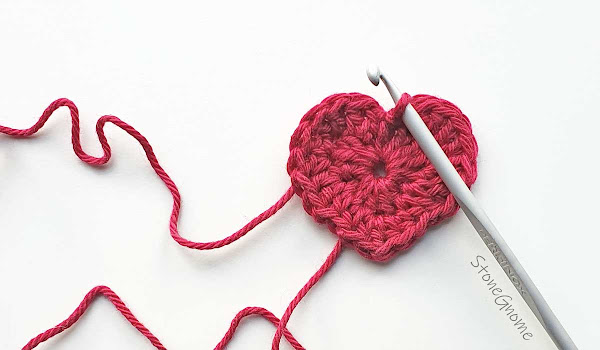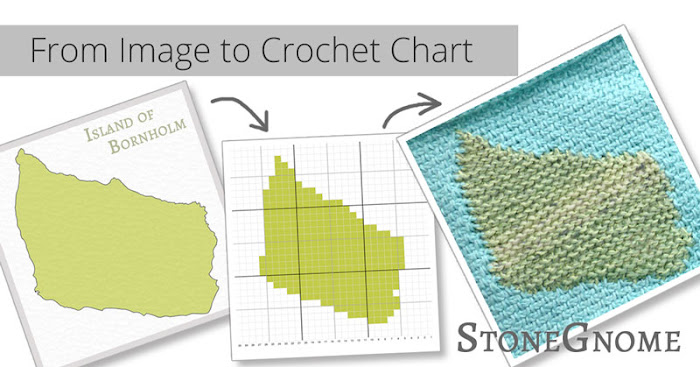Waistcoat stitches in the round are fantastic for colorwork. They stack neatly, create a smooth, uniform fabric, and fill up space beautifully.
If you’d like to try it, I’ve put together a small chart along with a few helpful tips.
Waistcoat stitches worked in the round are great for projects like pillows, bags, cowls, beanies, and more.
For my sample, I added 8 stitches to a round, and then the colorwork happened to fit an old glass. So, now the glass can be upgraded into a fancy crochet hook holder. - And yes, the glass is very happy with its new look.
The Heart Chart
I created the heart chart using StitchFiddle. I've shared it, so you can view or copy the chart for easy editing. FYI. StitchFiddle offers a handy progress tracker to help you keep your lines straight.
If you prefer a paper version, click and print this image.
Never tried a Crochet Chart before?
If you're new to reading crochet charts, don't despair, it is easy to learn the basics: Each rectangle in the chart represents one stitch. Since this pattern is worked in the round, keep working in the same direction and do not turn your work. Read every round from right to left (if you are left-handed from left to right) and keep following the chart in the same direction as you crochet.
Foundation. Chain 33 or more (I made 41).
- Work 1 single crochet stitch into each chain. (I prefer turning the chain over to insert my hook into the back bumps.). This is line 1 on the chart.
- Do not turn - instead, join into a ring by making a waistcoat stitch in the first stitch of your first line. Continue working in the round. As you follow the chart, work each stitch in the color shown for that rectangle.
- Continue working in the round and remember to change color right before every colored rectangle - see color change tip at the bottom of the page.
Repeat line 3.
❤️ · ❤️ · ❤️
Tips n Tricks
To get the best out of the waistcoat stitch colorwork, these additional notes can be helpful.
Keep the Waistcoat Stitches Straight
Waistcoat stitches don’t have to lean a lot! For a cleaner look make waistcoat stitches the right way. Insert your hook right before the vertical bar at the back of the stitch. (If you’re right-handed, this means inserting the hook on the right side of the bar.) This utilizes softer stitches and fabric and the stitches will lean a lot less.
Read more: Waistcoat stitch patterns in the round
Tension & Sizing
In case size is important to you.
- The chart is designed for a gauge of 20 stitches × 28 rows per 10×10 cm (4″×4″).
- I used a 4mm hook (US: G6) and Scheepjes Organicon, a very soft cotton yarn.
- The final size of my work will be around 10cm (4") wide and 8 cm (3.1") tall. - Remember I added 8 sts to the chart for a full round.
I crocheted quite tight, so you can likely achieve the same gauge with maybe a 3mm hook (US:~D3) and a looser tension.
The hearts should still look great even if your gauge isn’t exact, but if size matters, be sure to make a swatch first.
Tapestry or Not?
Decide whether you want to:
- Carry and crochet over the unused yarn throughout as for tapestry crochet
- or let the unused strands float on the back. If you want to keep them under control, either twist the strands or just crochet over the unused yarn at every 4-6 stitch
Note. In tapestry crochet using waistcoat stitches, it is easy to accidentally catch the carried yarn when pulling up a loop. Also, be aware that tapestry crochet makes the fabric slightly taller, as each row takes up more space.
Color Changes
Make smooth color transitions by changing color at the last yarn-over of the previous stitch - except when creating a single, isolated 'V' in the design. In that case, simply pull up the alternate color once, then continue with the main color.











 Have you ever wanted to put your own photo or image on a pillow or an afghan? You could also make a corner-to-corner (c2c) blanket or use the same technique for a filét chart or a sweater.
Have you ever wanted to put your own photo or image on a pillow or an afghan? You could also make a corner-to-corner (c2c) blanket or use the same technique for a filét chart or a sweater.







